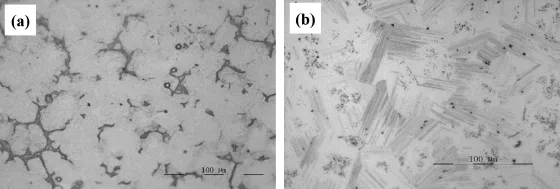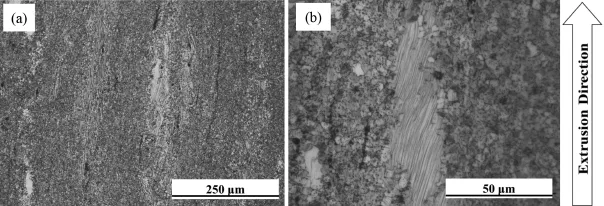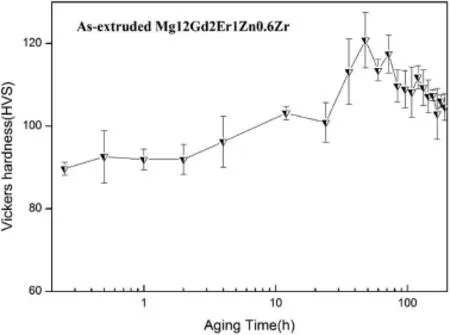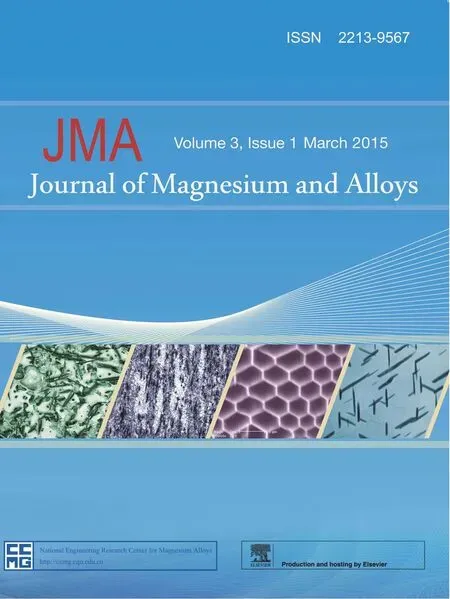Effect of microstructure evolution on mechanical property of extruded Mg-12Gd-2Er-1Zn-0.6Zr alloys
*
College of Materials Science and Engineering,Beijing University of Technology,Beijing 100124,PR China
Effect of microstructure evolution on mechanical property of extruded Mg-12Gd-2Er-1Zn-0.6Zr alloys
Kai Wen,Ke Liu,Zhaohui Wang,Shubo Li,Wenbo Du*
College of Materials Science and Engineering,Beijing University of Technology,Beijing 100124,PR China
The microstructure evolution of as-cast,as-extruded and peak-aged Mg-12Gd-2Er-1Zn-0.6Zr alloys were investigated by Optical Microscope(OM),X-ray Diffraction(XRD),Scanning Electron Microscope(SEM)and Transmission Electron Microscope(TEM).The mechanical performance was also tested by tensile test at room temperature in the present study.The results indicated that the lamellar 14H-LPSO structure formed during the solid solution process at 793 K for 24 h,and also existed after hot extrusion process.The dynamic recrystallization (DRX)occurred during hot extrusion.The DRXed fne grain size was~5 μm.Meanwhile,some un-DRXed grains contained LPSO structure had a roughly orientation along the extrusion direction.The tensile test result showed that the as-extruded alloy had a better elongation of 14%due to fne DRXed grain and fber-like un-DRXed with LPSO structure attributed to the high elongation.Because of the precipitation of the β′-phase, the ultimate tensile strength(UTS)and yield tensile strength(YTS)increased up to 415 MPa(UTS)and 374 MPa(YTS),respectively.
Mg-Gd-Er-Zn-Zr alloys;Mechanical properties;Dynamic recrystallization;LPSO
1.Introduction
In order to reduce emission of the greenhouse gas,the requirement for lightweight of motor vehicles is becoming more and more intensity.As the lightest structure metal, magnesium alloys are regarded as the best replacement of iron steel.The low density,good liquid molding property and high damping factor are considered as the advantages of magnesium alloys.However,the poor mechanical performance and deformation properties hinder the application of magnesium alloys in industry.Magnesium alloys containing rare earth (RE)have become a hot research issue in recent years because the admirable mechanical performance.
In the year 2001,Kawamura et al.[1]developed a high performance Mg97Zn1Y2alloy(at%)by using RS/PM method,which had high mechanical properties of yield tension strength of 610 MPa and elongation of 5%at room temperature.These high mechanical properties were attributed to not only the nano-level crystal grain but also the precipitation of long-period stacking order(LPSO)structure in the Mg-Zn-RE magnesium alloy.The LPSO structure has been also found in other magnesium alloys,in which the rare-earth(RE)elements are Y,Er,Gd,Dy and Ho[2].In recent years,much attention had been paid to the formation mechanism of the LPSO structure and its effect on the strength and ductility of magnesium alloys[3-6].According to reports,LPSO structure could form during casting[3], solution treatment[4],hot extrusion[5]and aging treatment process[6].Yoshimoto et al.[7]prepared an extruded Mg96Y2Zn2(at%)alloy with a yield tensile strength and anelongation of 390 MPa and 6.9%at room temperature, respectively.The improvement of mechanical properties was due to the fne LPSO structure and grains.Most of the magnesium alloys developed a sharp basal texture during extrusion process,which limits the wide application of the conventional magnesium alloys.However,adding RE elements into magnesium alloys could weaken the basal texture even form non-basal texture[8,9].
Gadolinium is a typical RE element for high solid solubility in magnesium.It can form S.S.S.S.(supersaturated solid solution)in matrix.Furthermore,the Mg-Gd secondary phase will be precipitated during heat treatment.One of the most important Mg-Gd phase is the β′phase which is metastable. The β′phase has a great effect on improving mechanical properties of alloys process signifcantly because of special orientation with Mg and dispersed distribution of the β′phase.
In the present research, we prepared Mg-12Gd-2Er-1Zn-0.6Zr alloy,which contains total content of RE element less than 15%.The cast alloy was solid soluted at 793 K for 24 h to obtain a high volume fraction of LPSO structure and make primary secondary phase dissolved into the Mg matrix,and then extruded and aging heat treatment were carried on the conditioned alloy. The microstructure and mechanical property were investigated for exploring a lower RE containing Mg alloy with a high strength.
2.Experiment procedures
The ingots of Mg-12Gd-2Er-1Zn-0.6Zr alloy(wt%) were prepared by 99.95%high pure Mg,99.9%pure Zn and Mg-30%Gd,Mg-30%Er,Mg-30%Zr master alloys in a graphite crucible heated by electric resistance furnace.The alloy was melted at 1033 K,then casted into a steel mold at 1013 K(ingot size:350×200×32 mm).The whole casting process was covered by anti-oxidizing mixture gas with 5% SF6and 95%(volume fraction)nitrogen.The composition of the as-cast alloy was tested by XRF(Magic PW2403 X-ray fuorescence analyzer),which was listed in Table 1.
The ingots were solid solute treated at 793 K for 24 h,then quenched into warm water.The solution treated ingots machined into small cylinder with a diameter of 35 mm for extrusion at 673 K with an extrusion ratio of 10.The asextruded alloy was performed to be aging at 498 K from 0.25 to 192 h.The phases were analyzed by X-ray diffraction (XRD,D8 ADVANCE)with Cu Kα radiation,and the microstructures were observed by OM(Zeiss Axio Imager A2m Optical Microscopy),SEM (HITACH S3400N Scanning Electric Microscopy)equipped with EDS(Energy Dispersive Spectrometer)and TEM(JEOL JEM-2100 Transmission Electron Microscopy).The samples for TEM observation were thinned to less than 70 μm by the mechanical polish method, then punched into thin plate with a diameter of 3 mm for ion beam milling and fnally it was polished by Gatan 691-type Ion Milling machine at 10°,6°and 2°.The micro Vickershardness was used to investigate the mechanical performance.The hardness test loads and dwelling time were 0.3 Kg and 10 s,respectively.Eight measurements were collected for each sample at least.
Tensile test was carried out by using a DNS-20 universal testing machine under a constant speed of 1.0 mm/min at room temperature.Specimens for the tensile test were made into dog-bone with a size of 5 mm gauge diameter and 25 mm gauge length.Three specimens were tested for each sample. All the tensile samples were sectioned in parallel to the extrusion direction.
3.Results and discussion
3.1.Microstructures of as-cast and as-extruded Mg-12Gd-2Er-1Zn-0.6Zr
Fig. 1(a) shows the OM image of as-cast Mg-12Gd-2Er-1Zn-0.6Zr alloy.It is indicated that the alloys are mainly composed of α-Mg matrix,dark gray eutectic phase and some focculent structure around the coarse eutectic phase.In our previous study,the coarse phase was considered as Mg5(Gd,Er,Zn)phase,and the focculent feature was a dense area of stacking faults.Fig.1(b)shows the OM image of heat treated alloy under a condition of 793 K for 24 h.It is indicated that the eutectic phase disappeared and some lamellar structure precipitated in the Mg matrix. Compared with Fig.1(a),the coarse Mg5(Gd,Er,Zn)phase was dissolved in the Mg matrix,and the volume fraction of the coarse Mg5(Gd,Er,Zn)phase decreases from 6.52%to nearly 0%.Meanwhile,the precipitated lamellar phase volume fraction increased to 30.01%.Fig.2 shows the XRD patterns of Mg-12Gd-2Er-1Zn-0.6Zr alloys in as-cast and as-solution states.The result indicates the intensity of the peaks corresponding to the Mg5(Gd,Er,Zn)phase decreased gradually after the heat treatment,which corresponds the change of the OM morphology.
Fig.3(a)shows the TEM bright feld(BF)images and the corresponding SAED pattern of the lamellar structure phase in the alloy heat treated at 793 K for 24 h.The TEM morphology shows the lamellar structure precipitated in the matrix,and the SAED pattern indicates that the 13 extra spots divide the correlation length of(002)matrixin the SAED pattern.The result shows that the 14H-LPSO structure is further confrmed in the alloy heat treated at 793 K for 24 h. The 14H-LPSO structure was also discovered by other researchers[10,11].The LPSO phase had a unique orientation in each Mg grain from the OM pictures shown in Fig.1.The 14H-LPSO structure located in grain boundary,nearly go through the whole grain,which length and distribution density are random.

Table 1Chemical composition of investigated alloy(mass fraction).

Fig.1.Optical microstructure of the alloy:(a)as-cast alloy(b)solid solution for 24 h at 793 K.
Fig.4 shows the OM picture parallel to the extruded direction.It could be found that the as-extruded alloy has an interesting microstructure.The DRXed(dynamic recrystallization)grains are refned slightly,which average grain size is less than 5 μm.Some unDRXed grains are stretched along the extruded direction,the LPSO structure distributes closely in the unDRXed grains,and the lamellar has a small orientation angle with the extruded axis.It was reported[3]that the 14HLPSO structure had two different morphology,the block like structure(X-phase)and lamellar structure.O~norbe et al.[12] had investigated the as-extruded Mg100-3xY2xZnxalloys (x=0.5,1.0 and 1.5 at%),it was reported that the existence of the LPSO structure with high volume fraction in alloys played an important role in enhancing the refnement of Mg DRX grains during hot extrusion,which due to the particle stimulate nucleation(PSN)mechanism.The effect was more obvious as the volume fraction of LPSO structure increased.In the study, the block X-phase(14H-LPSO)was not found in any stage during the heat treatment process.However,only the lamellar 14H LPSO structure was found in the conditioned alloy,and the grains containing the LPSO structure have a strong unique orientation along to the extrusion direction.

Fig.2.XRD pattern of as-cast and as-solution Mg-12Gd-2Er-1Zn-0.6Zr alloys.
Fig.5 shows the aging Time-Vickers hardness curve of the extruded alloy at 498 K for various times.The hardness value increases from 90 NHV to 123 NHV at peak age after isothermal heat treatment for 48 h.For investigate the improvement of hardness value,TEM test was carried on. Fig.6 shows the TEM morphology and corresponding SAED pattern.According to the bright fied TEM image,the peakaged alloy contains a high number density of fne precipitates,which distribute densely within the matrix.The equal spots between transmission spot diffraction spots,it suggests that the precipitation of the phase is β′-phase.The β′-phase was reported to have a base-centered orthorhombic (bco)structure with a=0.64 nm,b=2.22 nm and c=0.52 nm[5].There exists a defnite orientation relationship between β′phase and the matrix,i.e.[001]β′//[0001]Mg, (100)β′//(2110)Mg.
The LPSO structure was usually precipitated from the matrix during high temperature heat treatment[1,6].In our present study,the alloy was aged at relatively low temperature of 498 K,indicating that the LPSO structure might not precipitate from the supersaturated Mg matrix during the aging process until 200 h,and it was a thermally stable phase in traditional Mg alloys heat treatment conditions.So,compare with the image shows in Fig.3,the results show that the formation of LPSO structure in the study is at the stage of solid solution at high temperature.
3.2.Mechanical properties of Mg-12Gd-2Er-1Zn-0.6Zr
For investigate the mechanical property of the alloys at different conditions(as-cast,as-extruded and peak-aged)alloys at room temperature,the tensile test results were carried out.The test results are shown in Table 2.

Fig.3.TEM images of as-solution alloy at 793 K for 24 h and corresponding SAED pattern(EB//[1120]).
The as-cast alloy shows poor tensile properties.Its yield tensile strength(YTS),ultimate tensile strength(UTS)and elongation of the as-cast alloy are 143 MPa,203 MPa and 3.2%.The mechanical properties of the studied alloy are greatly enhanced after hot extrusion and the value of UTS, YTS and elongation increase to 344 MPa,243 MPa and 13.4%,respectively.According to the Hall-Petch equation, the refned DRXed grains enhance the YTS value and apart of UTS value,the fber-like unDRXed grains cause the anisotropy and enhance the UTS value.The values of UTS and YTS of the peak-aged alloy rise up to 415 MPa and 374 MPa, respectively.However,the elongation decreases to a poor value of 3.6%.The precipitation of the β′-phase and the growth of the grain size are response for the tremendous changes.
3.3.Discussion
As mentioned above,the formation of 14H-LPSO in the traditional cast method has an argument.It was an uncertain structure which has argument about the lamellar structure in some reports[3,6].Traditional research[6]results indicated that Mg-Zn-Gd LPSO structure should not appeared by conventional cast method ingots,but in recent studies,Wu et al.[3]frst observed lamellar structure in cast alloy and indicated that both 2H(Mg crystal structure)and 14H-type LPSO structure existed in Mg-Gd-Zn-Zr alloy.In our present study,the fne lamellar is not a perfect 14H-LPSO structure,but during the heat treatment at 798 K,the perfect 14H-LPSO structure formed and the volume fraction had increased.That had a good agreement with previous study. And its morphology from that was quite different from the block 14H-LPSO named X-phase.After hot extrusion,the lamellar LPSO contained grain played an important role.It was reported that the(0001)Mgbasal slip was the dominant deformation mode in LPSO phase[14,15].As it shown in Fig.4,it is easy to infer that the(0001)basal plane of the well aligned lamellar LPSO phase is roughly parallel to the extrusion direction[14,16].So,the loading direction is parallel to the extrusion direction,the basal slip Schmid factor is very small in the lamellar LPSO structure,resulted that the operation of basal slip is hard.Therefore,the lamellar LPSO structure is considered to be an effective strength structure in the extruded alloy.
Comparing with the as-extruded alloys,the strength of peak-aged alloys is increased and the elongation is decrease from 14%to 3.8%.The improvement of strength is mainly attributed to the following two factors.Firstly,the peak-aged alloy contains a high number density of β′-phases,which has been generally reported to play a key role in strengthening the magnesium alloys,β′-phases were observed to form on prismatic planes of α-Mg matrix phase with a triangular arrangement at the center of each face,which can effectively hinder the movement of basal plane dislocation.Secondly,the LPSO structure was reported much harder than the Mg-matrix [4,17],and could obtain the strengthening effect by amechanism of fber-like reinforcement.The decreasing of elongation is also caused by the precipitation of β′-phase, which hinder the movement of dislocation and make the basal plane slip,lead to the reducing of ductility.

Fig.4.Optical microstructure of as-extruded alloy parallel to the extruded direction.

Fig.5.Aging behaviors of the as-extruded alloy at 489 K different time.

Table 2Tensile property of the investigated alloys tested at room temperature.
4.Conclusion
In this study,we investigate the mechanical property of ascast,as-extruded and peak-aged Mg-12Gd-2Er-1Zn-0.6Zr alloys.The technology route is solution at 793 K for 24 h, extrudedat673Kandagingfor48hat498K.Onlythelamellar structure LPSO is found in the studied alloy,and it is quite different from previous research.After the hot extrusion process,the LPSO structure has a unique orientation along to the extrusion direction.However,some unDRXed grain containing LPSO structure has also been stretched along this direction, which causes a high elongation rate of 13.4%.After aging treatment for 48 h to obtain the peak-aged alloy,the LPSOstructure still exists coexisting with the precipitation of the β′phase,which results in the high value of UTS and YTS.The values of the UTS and YTS are 415 and 374 MPa,respectively. Meanwhile,the elongation decreases to 3.6%rapidly.

Fig.6.TEM morphology and corresponding SAED pattern.(a,b)β′-phase(0001)Mg;(c,d)LPSO
Acknowledgment
This projects was supported by Projects(2142005)supported by Beijing Natural Science Foundation;Projects (KM201310005001)supported by Beijing Municipal Commission of Education.
[1]Y.Kawamura,K.Hayashi,A.Inoue,T.Masumoto,Mater.Trans.42(7) (2001)1172-1176.
[2]Y.Kawamura,M.Yamasaki,Mater.Trans.11(48)(2007)2986-2992.
[3]Y.J.Wu,D.L.Lin,X.Q.Zeng,L.M.Peng,W.J.Ding,J.Mater.Sci.44 (2009)1607-1612.
[4]T.Itoi,T.Seimiya,Y.Kawamura,M.Hirohashi,Scr.Mater.51(2004) 107-111.
[5]E.Abe,Y.Kawamura,K.Hayashi,A.Inoue,Acta Mater.50(2002) 3845-3857.
[6]M.Yamasaki,M.Sasaki,M.Nishijima,K.Hiraga,Y.Kawamura,Acta Mater.55(2007)6798-6805.
[7]S.Yoshimoto,M.Yamasaki,Y.Kawamura,Mater.Trans.47(2006) 959-965.
[8]E.A.Ball,P.B.Prangnell,Scr.Metal.Mater.31(1994)111-116.
[9]S.R.Agnew,M.H.Yoo,C.N.Tome,Acta Mater.49(2001)4277-4289.
[10]Y.J.Wu,D.Lin,X.Q.Zeng,L.M.Peng,W.J.Ding,J.Mater.Sci.44(6) (2009)1610.
[11]S.Zhang,G.Y.Yuan,C.Lu,W.J.Ding,J.Alloys Compd.509(8)(2011) 3515-3521.
[12]E.O~norbe,G.Garc′es,P.P′erez,P.Adeva,J.Mater.Sci.14(47)(2012) 1085-1093.
[14]K.Hagihara,N.Yokotani,Y.Umakoshi,Intermetallics 18(2010) 267-276.
[15]K.Hagihara,A.Kinoshita,Y.Sugino,M.Yamasaki,Y.Kawamura, H.Y.Yasuda,Y.Umakoshi,Intermetallics 18(2010)1079-1085.
[16]Z.Leng,J.H.Zhang,M.L.Zhang,X.J.Liu,H.B.Zhan,R.Z.Wu,Mater. Sci.Eng.A 540(2012)38-45.
[17]Y.Q.Chi,M.Y.Zheng,C.Xu,Y.Z.Du,X.G.Qiao,K.Wu, X.D.Liu,G.J.Wang,X.Y.Lv,Mater.Sci.Eng.A 565(2013) 112-117.
Received 9 October 2014;revised 28 November 2014;accepted 3 December 2014 Available online 21 January 2015
*Corresponding author.Tel./fax:+86 10 67392917.
E-mail addresses:wenkai-bjut@emails.bjut.edu.cn(K.Wen),lk@bjut.edu. cn(K.Liu),wangzhaohui@bjut.edu.cn(Z.Wang),lishubo@bjut.edu.cn(S. Li),duwb@bjut.edu.cn(W.Du).
Peer review under responsibility of National Engineering Research Center for Magnesium Alloys of China,Chongqing University.
http://dx.doi.org/10.1016/j.jma.2014.12.003.
2213-9567/Copyright 2015,National Engineering Research Center for Magnesium Alloys of China,Chongqing University.Production and hosting by Elsevier B.V.All rights reserved.
Copyright 2015,National Engineering Research Center for Magnesium Alloys of China,Chongqing University.Production and hosting by Elsevier B.V.All rights reserved.
 Journal of Magnesium and Alloys2015年1期
Journal of Magnesium and Alloys2015年1期
- Journal of Magnesium and Alloys的其它文章
- Improved mechanical proprieties of“magnesium based composites”with titanium-aluminum hybrids
- Effect of single Si1-xCxcoating and compound coatings on the thermal conductivity and corrosion resistance of Mg-3Sn alloy
- Investigation on mechanical properties and creep behavior of stir cast AZ91-SiCpcomposites
- Effects of Bi on the microstructure and mechanical property of ZK60 alloy
- Multi-response optimization of process parameters in friction stir welded AM20 magnesium alloy by Taguchi grey relational analysis
- Polyaspartic acid as a corrosion inhibitor for WE43 magnesium alloy
